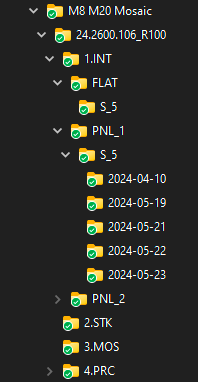Hi folks,
I need some suggestions.. per my subject line, how are you all organizing your lights and calibration frames??
I image with a ASIair… and generally I plug in a 16GB usb thumb drive into one of the USB ports for the night to store my images.
When the session is over, or the next day, I'll remove the thumb drive and transfer all of the frames to a external 500GB SSD drive. Orginally I had a parent folder for each object, and within that parent folder, I had my sub-folders for the lights, darks biases and flats.
When I first begain playing around imaging DSO's I normally used the same gain, and exposure time setings, and to reduce the amount of space i was using on the SSD, I paired down the folders to just lights, and had another parent folder called Master Calibration, and called that good. But now that I've began to experiment with different exposure time and gain settings… I'm getting confused as to which calibration files I need to use with which lights.
One of the things I'm going to need to do is start a notebook for my imaging sessions and write down EVERYTHING I do with regards to changes to the imaging rig for the session…. But as far as my imaging frames go, I'm considering going back to the Parent folder for each object I image, and have sub-folders for all of my lights, and calibration frames.. even thou this will use up more drive space with duplicate calibration frames.. at least if I want to re-stack or color process an object later with a new technique… I'm not left scratching my head trying to remeber what calibration frames I used.
For you folks that have been doing this for a while, how are you organizing your files??
Thanks
I need some suggestions.. per my subject line, how are you all organizing your lights and calibration frames??
I image with a ASIair… and generally I plug in a 16GB usb thumb drive into one of the USB ports for the night to store my images.
When the session is over, or the next day, I'll remove the thumb drive and transfer all of the frames to a external 500GB SSD drive. Orginally I had a parent folder for each object, and within that parent folder, I had my sub-folders for the lights, darks biases and flats.
When I first begain playing around imaging DSO's I normally used the same gain, and exposure time setings, and to reduce the amount of space i was using on the SSD, I paired down the folders to just lights, and had another parent folder called Master Calibration, and called that good. But now that I've began to experiment with different exposure time and gain settings… I'm getting confused as to which calibration files I need to use with which lights.
One of the things I'm going to need to do is start a notebook for my imaging sessions and write down EVERYTHING I do with regards to changes to the imaging rig for the session…. But as far as my imaging frames go, I'm considering going back to the Parent folder for each object I image, and have sub-folders for all of my lights, and calibration frames.. even thou this will use up more drive space with duplicate calibration frames.. at least if I want to re-stack or color process an object later with a new technique… I'm not left scratching my head trying to remeber what calibration frames I used.
For you folks that have been doing this for a while, how are you organizing your files??
Thanks
